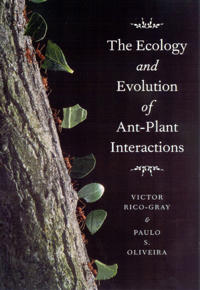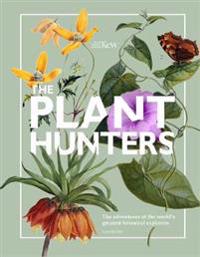Plant Biotechnology (Pocket)
avAdrian Slater, Nigel W. Scott, Mark R. Fowler
ISBN: 9780199282616 - UTGIVEN: 200806Throughout history, humankind has pursued means to improve the yield of crop plants through selective plant breeding and hybridization. Today, genetic manipulation provides a powerful tool for directing plant breeding. But how is genetic manipulation implemented? What benefits can it offer? And what[...]
Plant-animal Communication (Pocket)
avH. Martin Schaefer, Graeme D. Ruxton
ISBN: 9780199563593 - UTGIVEN: 2011-04-07A summary of the diverse communication systems between plants and animals. This book explains the theoretical foundations of communication and applies them to the diverse processes in which plants can act as prey or predators of animals. It lays out fundamental concepts such as deception, reliabilit[...]
A Dictionary of Plant Sciences (Häftad)
avMichael Allaby
ISBN: 9780199600571 - UTGIVEN: 201203Completely revised and updated with over 250 new entries, the third edition of this dictionary offers broad coverage of all aspects related to the field of plant sciences including biochemistry, plant physiology, cytology, ecology, genetics, evolution, biogeography, earth history, and earth sciences[...]
The Neo-Liberal State (Pocket)
avRaymond Plant
ISBN: 9780199650576 - UTGIVEN: 201209The aim of the book is two-fold. First of all it is to provide a fair, complete and analytical account of the Neo-liberal conception of the role and function of the state in modern society. The second aim is to provide a critical assessment of some of the central elements of this conception. The boo[...]
Latin for Gardeners: Over 3,000 Plant Names Explained and Explored (Inbunden)
avLorraine Harrison
ISBN: 9780226009193 - UTGIVEN: 201210Since Latin became the standard language for plant naming in the eighteenth century, it has been intrinsically linked with botany. And while mastery of the classical language may not be a prerequisite for pruning perennials, all gardeners stand to benefit from learning a bit of Latin and its convent[...]
The Plant Hunters: The Adventures of the World's Greatest Botanical Explorers (Inbunden)
ISBN: 9780226093314 - UTGIVEN: 2013-09From geraniums to begonias, the common plants that often adorn backyard gardens are rarely native to our region. The same goes for many of the diverse and delicious fruits and vegetables that grace our dinner tables. We take their accessibility and ubiquity for granted, unaware of the great debt we [...]
Plant Physics (Pocket)
avKarl J. Niklas, Hanns-Christof Spatz, Karl J. Niklas
ISBN: 9780226150819 - UTGIVEN: 2014-02From Galileo, who used the hollow stalks of grass to demonstrate the idea that peripherally located construction materials provide most of the resistance to bending forces, to Leonardo da Vinci, whose illustrations of the parachute are alleged to be based on his study of the dandelion's pappus and t[...]
Wonders of the Plant Kingdom: A Microcosm Revealed (häftad)
ISBN: 9780226215921 - UTGIVEN: 2015-02Compared to the obvious complexity of animals, plants at a glance seem relatively simple in form. But that simplicity is deceptive: the plants around us are the result of millennia of incredible evolutionary adaptations that have allowed them to survive, and thrive, under wildly changing conditions [...]
Plant Sensing and Communication (Häftad)
avRichard Karban
ISBN: 9780226264707 - UTGIVEN: 2015-07The news that a flowering weed-mousear cress (Arabidopsis thaliana)-can sense the particular chewing noise of its most common caterpillar predator and adjust its chemical defenses in response led to headlines announcing the discovery of the first "hearing" plant. As plants lack central nervous syste[...]
Plant Evolution (häftad)
ISBN: 9780226342146 - UTGIVEN: 2016-09Although plants comprise more than 90% of all visible life, and land plants and algae collectively make up the most morphologically, physiologically, and ecologically diverse group of organisms on earth, books on evolution instead tend to focus on animals. This organismal bias has led to an incomple[...]
A Portable Latin for Gardeners: More Than 1,500 Essential Plant Names and the Secrets They Contain (häftad)
ISBN: 9780226455365 - UTGIVEN: 2017-02Having an understanding of botanical Latin unlocks an entirely new layer of the plant world. Gardeners deciding between a Crocus flavus and Crocus graveolens will know that one produces deep yellow flowers while the other boasts a prominent smell. They can tell whether a plant should have one (unifo[...]
Plant Families: A Guide for Gardeners and Botanists
ISBN: 9780226523088 - UTGIVEN: 2017-10Most of us lump plants together in one big family, and when pressed can only explain their grouping by what they're not--not an animal, not a mineral, and so just a plant. In reality, there are hundreds of different plant families, each grouped logically by a unique family history and genealogy. Thi[...]
Plant Biomechanics (Häftad)
avKarl J. Niklas
ISBN: 9780226586311 - UTGIVEN: 199205In this first comprehensive treatment of plant biomechanics, Karl J. Niklas analyzes plant form and provides a far deeper understanding of how form is a response to basic physical laws. He examines the ways in which these laws constrain the organic expression of form, size, and growth in a variety o[...]
Plant Physics (Inbunden)
avKarl J. Niklas, Hanns-Christof Spatz
ISBN: 9780226586328 - UTGIVEN: 201203From Galileo, who used the hollow stalks of grass to demonstrate the idea that peripherally located construction materials provide most of grass' resistance to bending forces, to Leonardo da Vinci, whose illustrations of the parachute are alleged to be based on his study of the dandelion's pappus an[...]
The Ecology and Evolution of Ant-Plant Interactions
ISBN: 9780226713489 - UTGIVEN: 2007-07Ants are probably the most dominant insect group on Earth, representing ten to fifteen percent of animal biomass in terrestrial ecosystems. Flowering plants, meanwhile, owe their evolutionary success to an array of interspecific interactions - such as pollination, seed dispersal, and herbivory - tha[...]
Plant-pollinator Interactions (Häftad)
avMichael Dory, Adam Parrish, Brendan Berg
ISBN: 9780226874005 - UTGIVEN: 200601Just as flowering plants depend on their pollinators, many birds, insects, and bats rely on plants for energy and nutrients. This plant-pollinator relationship is essential to the survival of natural and agricultural ecosystems. "Plant-Pollinator Interactions" portrays the intimate relationships of [...]
Footprints of the Forest: Ka'apor Ethnobotany - The Historical Ecology of Plant Utilization by an Amazonian People (Övrig)
avWilliam L. Balee
ISBN: 9780231074858 - UTGIVEN: 1999-10-20Footprints of the Forest is the clearest and most comprehensive account to date of the relationship between an Amazonian people and their botanical environment. Based on Balee's ten years of ethnological and botanical research among the Tupi-Guarani-speaking Indians, especially the Ka'apor, of east[...]
Plant Taxonomy: The Systematic Evaluation of Comparative Data (Övrig)
avTod F. Stuessy
ISBN: 9780231147125 - UTGIVEN: 2008-12-10The field of plant taxonomy has transformed rapidly over the past fifteen years, especially with regard to improvements in cladistic analysis and the use of new molecular data. The second edition of this popular resource reflects these far-reaching and dramatic developments with more than 3,000 new [...]
The Philosopher's Plant (Inbunden)
avMichael Marder, Mathilde (ILT) Roussel, Michael Marder
ISBN: 9780231169028 - UTGIVEN: 2014-11Despite their conceptual allergy to vegetal life, philosophers have used germination, growth, blossoming, fruition, reproduction, and decay as illustrations of abstract concepts; mentioned plants in passing as the natural backdrops for dialogues, letters, and other compositions; spun elaborate alleg[...]
The Philosopher's Plant (Pocket)
avMichael Marder, Mathilde (ILT) Roussel, Michael Marder
ISBN: 9780231169035 - UTGIVEN: 2014-11Despite their conceptual allergy to vegetal life, philosophers have used germination, growth, blossoming, fruition, reproduction, and decay as illustrations of abstract concepts; mentioned plants in passing as the natural backdrops for dialogues, letters, and other compositions; spun elaborate alleg[...]
The Plant Hunters: The Adventures of the World's Greatest Botanical Explorers (Inbunden)
avCarolyn Fry
ISBN: 9780233003566 - UTGIVEN: 201208From the Ancient Egyptians to the travelers along the silk and spice routes to the scientists still uncovering nearly 200 species a day, "Plant Hunters" tells the story of our obsession with all things that grow-both for their beauty and their economic potential. Accompanied by hundreds of beautiful[...]
The Plant Hunters
ISBN: 9780233005164 - UTGIVEN: 2017-08The Plant Hunters tells the story of our fascination with plants and the discovery of new species. From ancient times, when Alexander the Great included naturalists in his entourage, this intriguing story moves across the world, as plants such as coconut trees, roses and numerous fruits and vegetabl[...]



























